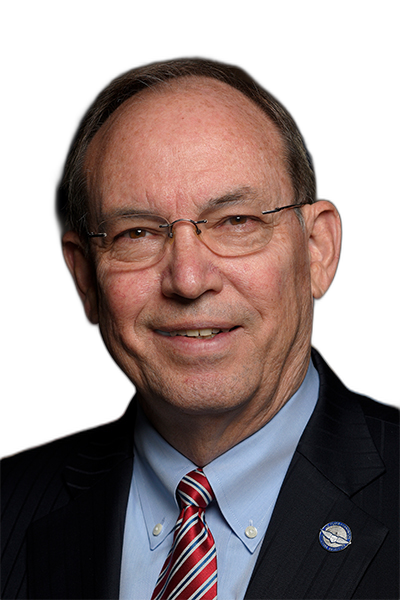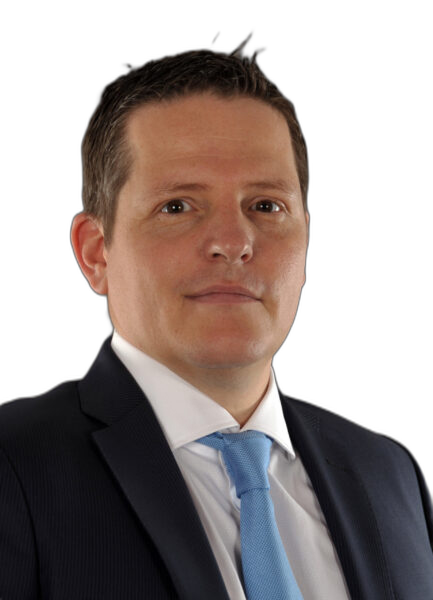Space Operations and Digital Technology
The current reality is that most of what we know about space and most of what we do in space occurs through a digital interface. The vast majority of work conducted in space is done by people on Earth; very few are fortunate enough to actually work in space. This is especially true for those serving in national security space. For example, Guardians in Colorado conduct the preponderance of the space-based missile warning, communication, weather, and position, navigation, and timing (PNT) operations of the United States Space Force (USSF). The dependence of space operations on digital technology is undeniable. Rather than looking at this as a limitation, existing and emerging spacefaring organizations should consider this an opportunity to leverage digital tools in innovative ways and to a greater extent than in any other domain. They should embrace space as a digital frontier.
Examining the U.S. Space Force’s vision and ongoing integration of digital technology can inform the decisions of other space organizations. The USSF’s objective of applying digital technology to every aspect of its mission is ambitious, and, therefore, this case study will have lessons to offer other space organizations, whether they operate a single satellite or have an extensive infrastructure of sensors, satellites, ground stations, and launch complexes. User-defined dashboards, robotic process automation (RPA), and the use of artificial intelligence (AI) and machine learning (ML) are all digital applications the USSF is using to make its lean force more effective and efficient across the spectrum of its functions.
The USSF is the only new U.S. military Service established this century. As a result, it was “born digital,” a concept embraced and promulgated by General Raymond, the first Chief of Space Operations (Hitchens, 2023). However, like all newborns, being “born digital” does not make it a mature and fully digital Service from inception. The early development of the Service only continues to reemphasize the inextricable dependency of current space development, acquisition, and operations on digital technologies, and the additional development and integration of digital tools are ongoing processes for the USSF. To spearhead this effort, General Raymond created a new staff office to lead and champion the digital transformation of the USSF: the Chief Technology and Innovation Office (CTIO). The CTIO combined functions, including science, research, digital transformation, innovation, data management, technology infrastructure, and analysis under one umbrella organization. The CTIO leads pilot initiatives and synchronizes digital activities across the USSF to provide direction and increase the efficiency and effectiveness of the handful of personnel assigned to the Service.
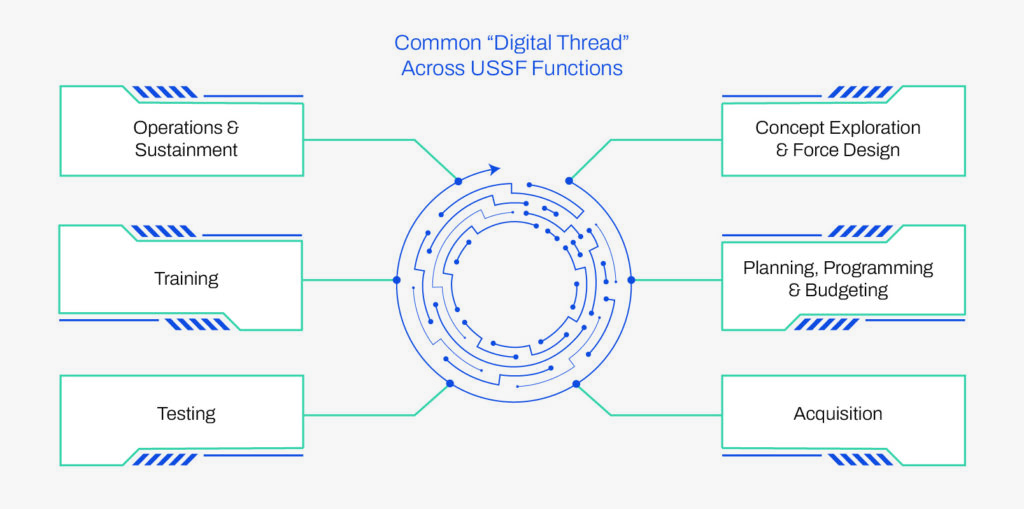
One of the first documents from the CTIO was the “USSF Vision for a Digital Service” (U.S. Space Force Vision for a Digital Service, 2021). It was intended to provide a foundational level of understanding about what being a digital Service meant as well as present an aspirational image of what the Service could become by adopting digital tools and processes. It described an interconnected, common “digital thread” woven across all missions, functions, and activities of the USSF, from force design, requirements, planning, budgeting, acquisition, test, training, operations, and sustainment. The Space Force intends to streamline the transition between and among these functions with a single common digital thread, ultimately to deliver and iterate capabilities faster than before.
Another advantage of this approach is its ability to bring together experts of different perspectives and roles to collaborate within each of these functions. Instead of a model in which operators wait to receive a system in a serial process, the digital thread model allows operators, developers, acquirers, and planners to all collaborate in a development, security, and operations (DevSecOps) framework, more commonly used in software and information technology (IT) development. DevSecOps should increase the transparency of the capabilities and limitations, costs, and timelines of the system in development. Reinforcing this concept of digital transformation for all aspects of the USSF are four overlapping focus areas, again encompassing every corner of the new Service. Each of these four areas has specific and discrete objectives of its own, but the true benefit is commonly realized in the overlap areas of two or more focus areas.
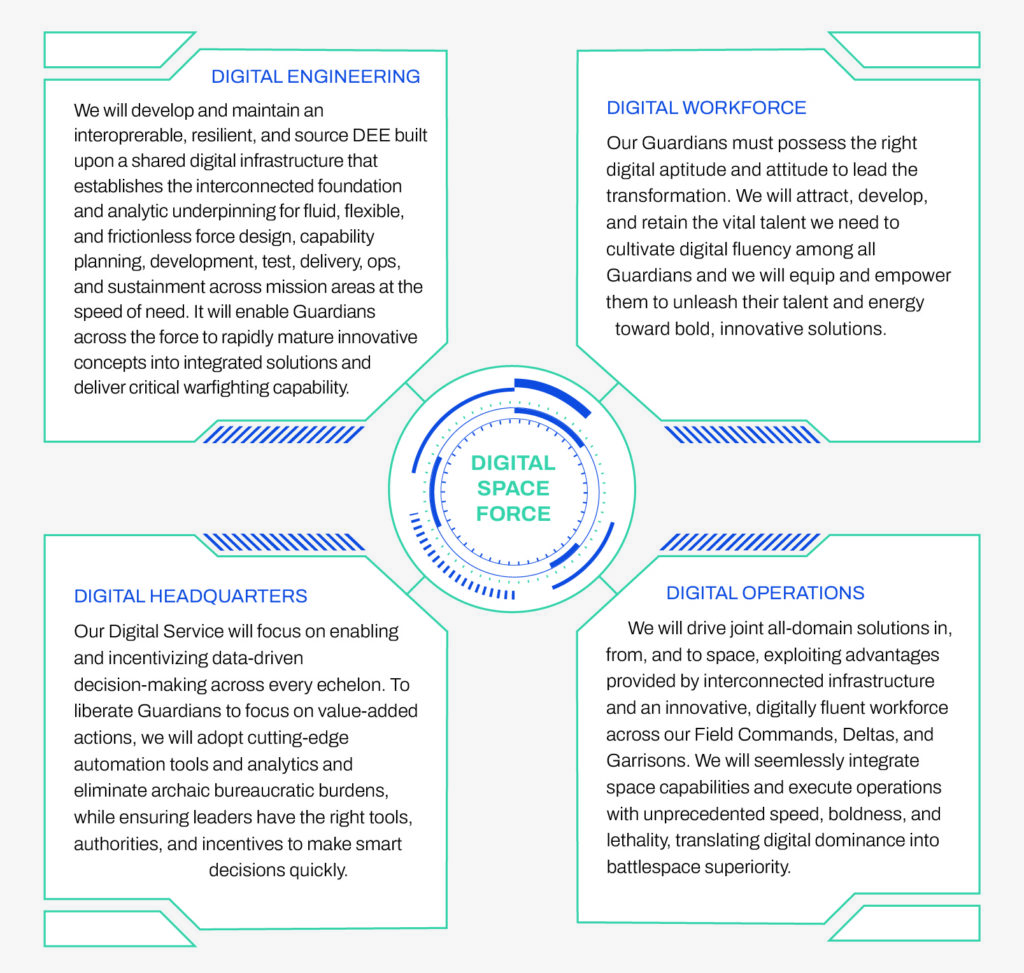
Digital Workforce
Even though space activities and digital transformation deal with technology, it is people who deliver capability and mission success. For this reason, the first focus area is the digital workforce. For the USSF digital transformation, it is important to develop a workforce with the right aptitude and attitude. Aptitude includes the background, skills, education, and training of the workforce, while attitude focuses on creating a culture of risk-taking, innovation, and the willingness to try new things and not accept the status quo.
The USSF recognizes the diverse experiences and views of technology in its Guardians. From senior personnel whose formative years occurred prior to the internet to junior personnel who have only known a world with computers, smartphones, and global interconnectivity, this broad spectrum highlights the importance of creating a baseline level of familiarity for all Guardians through a set of virtual training modules offered through Digital University. (Digital University, n.d.) These force multiplier modules were intended to solidify a common vocabulary and understanding of basic digital processes and technology—to create a baseline level of digital fluency. While a foundational level of understanding is essential, deeper, more specialized training for small groups of personnel is also essential.
For the USSF, one of the first programs to provide this type of advanced training was the Software Development Immersive program. (supracoders.us, n.d.) Here, Guardians from all career fields with a displayed requisite aptitude and proficiency receive intense training on software coding practices and demonstrate those skills in a capstone project. Graduates of this program, known as “Supra Coders,” return to their unit armed with the skills and confidence to make adjustments to their organization’s software and create tools to more effectively complete their mission. Supra Coders also receive a skill identifier, which the Space Force can then use to ensure their talent is applied in subsequent assignments throughout their career. This talent management is an illustration of the overlap between the Digital Workforce and Digital Headquarters.
Digital Headquarters
Despite what the name might imply, Digital Headquarters does not just apply to activities in the Pentagon. Instead, it is aimed at improving and streamlining the decision-making process at all echelons and ensuring decision-makers have access to the data necessary to make informed choices. Personnel management, such as tracking Supra Coders, is one example. Tracking the fitness of military members is another. The USSF can collect fitness data on Guardians more frequently through the use of wearable technology, which generates a more accurate representation of overall health than the traditional once-a-year fitness test. (Cohen, 2023) This additional information enables data-driven decision-making at the unit level, as well as for policy decisions across the entire USSF. Regardless of level, visualization of data through dashboards is a particularly useful tool. Dashboards can quickly depict systems or personnel readiness, force strength, program status, and demographics, to name a few examples, making the information they convey easier for decision-makers to integrate into their calculus. Additionally, by properly configuring the data source with the dashboard, automated real-time—or at least more frequent—updates of the information are possible. The contrast is the traditional, labor-intensive process of manually building charts. Proper alignment of data, systems, and networks introduces the third focus area, concentrating on the infrastructure and the use of digital models to represent actual systems.
Digital Engineering
Within the four focus areas, the USSF decided to combine the underlying digital infrastructure with the more traditional development activities typically found in digital engineering. Here, the networks, interfaces, data, models, and mission systems all reside in standardized, modular, open formats. The USSF’s objective with digital engineering is to create the interconnected digital ecosystem necessary for all elements of the Space Force. In its boldest vision, what the CTIO termed the SpaceVerse, this would become an environment where users could seamlessly access data at multiple security levels, collaborate, decide, and execute those decisions via virtual reality and augmented reality user interfaces for all functions, from concept exploration to operations. (Underwood, 2022a)
The USSF quickly recognized that existing networks and systems must either be upgraded or replaced to achieve the bandwidth, processing speed, and compatibility required to enable the application of AI/ML tools, real-time collaboration, and mission execution. While the USSF is a new Service, it inherited legacy networks and IT infrastructure from its predecessor organizations, primarily from the United States Air Force. Some of these systems originate from before the advent of the World Wide Web (Galbreath, 2023). Given the breadth and depth of modifications required, the USSF must pursue incremental improvements to its infrastructure. Coincidentally, this means it may be easier for new-entrant spacefaring nations or organizations to establish their digital ecosystem than for the United States to update and integrate theirs.
Essential to the USSF digital transformation and employment of AI/ML tools is access to data. For the USSF, this largely falls to increasing access to and the expansion of the Unified Data Library (UDL), the cloud-based repository of military space domain awareness data. (Gill, 2023) Originally built as a research tool, the UDL quickly became a vital repository of data for operational users. A current initiative of the CTIO is to enhance the UDL with increased connectivity and access to commercial and partner data sources and additional sensors. This would drastically increase the amount of data contained in the UDL. Since AI/ML tools are “trained” on data sets, the more quality data available, the better and more accurate the AI/ML tools. (Morrell, 2021)
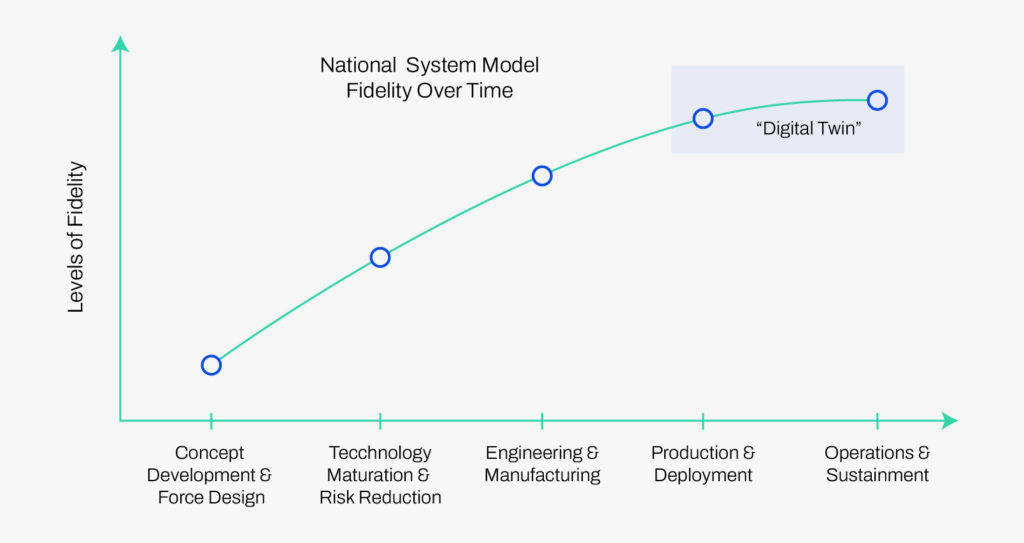
A key element of digital infrastructure improvements and a more typical component of digital engineering is the development of models leading to digital twins. Models of capabilities serve a valuable role across all functions of the USSF. However, the level of fidelity or detail available over time and used within particular phases is different. For example, a full-fidelity digital twin is neither possible nor needed during concept exploration and force design activities. This is true for new and legacy systems, which means it may not be necessary to develop a full digital twin of the legacy GPS II to explore concepts for what will come after GPS III. This eliminates the need to retroactively create detailed digital models of legacy systems to make architecture trades. Instead, the requirement and expectation for detailed digital models is applied to new systems and only employed for subsystems of legacy capabilities as mission requirements dictate. As a new program progresses through the development process, the digital model of that capability and its subsystems will gain increasing levels of detail and fidelity until a digital twin is established close to the deployment of the physical capability. In addition to the well-established benefits of digital engineering and the use of digital twins for development activities, they also enable the opportunity for robust training of operators (www.boozallen.com, n.d.). A digital twin accessible to operational crews before launch of the physical satellite gives those crews the opportunity to gain proficiency and develop tactics, techniques, and procedures (TTPs) for mission execution, responses to natural and manmade hazards, and responses to anomalies.
Ideally, training with digital models would occur in a simulated operational environment as close to actual as possible and include physics-based modeling and simulation (M&S), threat representation, and user interfaces. The USSF is pursuing the creation of this environment as the digital component of the National Space Test and Training Complex (NSTTC) (Vision for the National Space Test and Training Complex (NSTTC), 2022). The NSTTC is envisioned as a hybrid environment that includes electromagnetic, orbital, and cyber ranges, as well as a virtual component called the NSTTC-Digital. Here, Guardians will be provided with “hybrid digital environments, infrastructure-based digital connectivity, and cradle-to-grave Modeling & Simulation (M&S) to enable system concept studies, development, test, training, exercises, and wargaming” (Vision for the National Space Test and Training Complex (NSTTC), 2022). If successful, this will be an incredible asset to accelerate the development and fielding of capabilities and will go a long way to achieving the SpaceVerse vision. The major missing element is the ability to conduct real-world operations from the same virtual environment, thus eliminating any variation between training and operating experiences for the user. However, this does not mean digital operations are a concept for the future.
Digital Operations
The integrated efforts of the three previous focus areas culminate in digital operations. Today, Supra Coders, using existing digital infrastructure, are creating programs and tools to inform operational decisions on a daily basis. These activities range from crew scheduling, data management, sensor optimization, operational readiness tracking, and robotic process automation to free personnel from mundane, labor-intensive tasks. Developers and operators are also working collaboratively to employ AI/ML algorithms to sift through space surveillance data more effectively and faster than previously possible—an absolute necessity given the rapid increase in objects in orbit (Underwood, 2022b). Further, digital twins are already used to help troubleshoot on-orbit anomalies. As technology matures and Guardians continue to embrace the use of digital tools, the possibilities for adopting new digital operations improvements are vast.
Summary
The inherent reliance on digital interfaces for Earth-bound space professionals makes the adoption of digital tools to support space development and operations a necessity. The United States Space Force offers a comprehensive look at how spacefaring organizations can embrace digital technology and practices to improve their effectiveness and efficiency. The bold and extensive vision for the USSF digital transformation may not be fully applicable for all, but elements of their ongoing and planned activities can help inform the efforts of others.
Fundamentally, the USSF digital transformation is as much about its people as it is about technology. Training and preparing Guardians to appropriately use digital tools to improve their effectiveness is a key goal. A fully integrated digital enterprise would enable them to make informed, data-driven decisions at all levels of the organization. Improving the infrastructure and data accessibility to create a collaborative environment is foundational. It will allow the seamless execution of diverse functions throughout the life cycle of systems and ultimately enable the real-world operations of physical assets via digital interfaces.
It is important to remember that digital transformations and the use of AI/ML algorithms are mechanisms to make human personnel more effective. Like all tools, they have limitations and are not suited for all tasks.
– Charles Galbreath
It is important to remember that digital transformations and the use of AI/ML algorithms are mechanisms to make human personnel more effective. Like all tools, they have limitations and are not suited for all tasks. They are not magic wands. Users and developers must understand the capabilities and limitations of the resources available to them and make informed decisions about which tool to apply and in what circumstances. It is also important to remember the USSF digital transformation is an ongoing, and even perpetual, effort. There is no finish line or single objective resulting in a declaration of success. However, the extent and speed to which the USSF is able to implement its vision can serve as a useful guide for others to follow and learn from.
References
Booz Allen Hamilton (n.d.), ‘Digital Engineering: An Agile Approach.’
Available at: https://www.boozallen.com/expertise/digital-engineering.html.
Cohen, R. (2023) ‘The Space Force’s new fitness regime has landed,’ Air Force Times, 25 May.
Available at: https://www.airforcetimes.com/news/your-air-force/2023/05/25/the-space-forces-new-fitness-regime-has-landed/.
Digital University. (n.d.). Digital University. Available at: https://digitalu.af.mil/
Galbreath, C. (2023) ‘Building U.S. Space Force Counterspace Capabilities: An Imperative for America’s Defense,’ The Mitchell Institute for Aerospace Studies, 26 June.
Available at: https://mitchellaerospacepower.org/building-u-s-space-force-counterspace-capabilities-an-imperative-for-americas-defense/.
Gill, J. (2023) ‘Space Force wants $187M to “enhance” its Unified Data Library, Breaking Defense, 24 March.
Available at: https://breakingdefense.com/2023/03/space-force-wants-187m-to-enhance-its-unified-data-library/
Hitchens, T. (2023) ‘Though ‘born digital,’ Space Force needs 7 years to fully mature, deputy CTIO says,’ Breaking Defense, 12 January.
Available at: https://breakingdefense.com/2023/01/though-born-digital-space-force-needs-7-years-to-fully-mature-deputy-ctio-says/
Morrell, J. (2021) ‘Does More Data Equal Better Analytics?’ Datameer, 1 July.
Available at: https://www.datameer.com/blog/does-more-data-equal-better-analytics/#:~:text=More%20Data%20%3D%20Better%20Training,use%20to%20train%20the%20modelsupracoders.us. (n.d.). Supra Coders. Available at: https://supracoders.us/.
Underwood, K. (2022). ‘Introducing the SpaceVerse,’ Signal Media, 29 June.
Available at: https://www.afcea.org/signal-media/introducing-spaceverse
Underwood, K. (2022) ‘Combining Research with Space Operations,’ Signal Media, 11 October.
Available at: https://www.afcea.org/signal-media/combining-research-space-operations
U.S. Space Force: Vision for a Digital Service. (2021) Washington, DC: U.S. Space Force, CTIO.
Available at: https://media.defense.gov/2021/May/06/2002635623/-1/-1/1/USSF%20VISION%20FOR%20A%20DIGITAL%20SERVICE%202021%20%282%29.PDF
Vision for the National Space Test and Training Complex (NSTTC). (2022) U.S. Space Force, Space Training and Readiness Command.
Available at: https://www.starcom.spaceforce.mil/Portals/2/NSTTC%20Vision_PA%20Final_1.pdf




